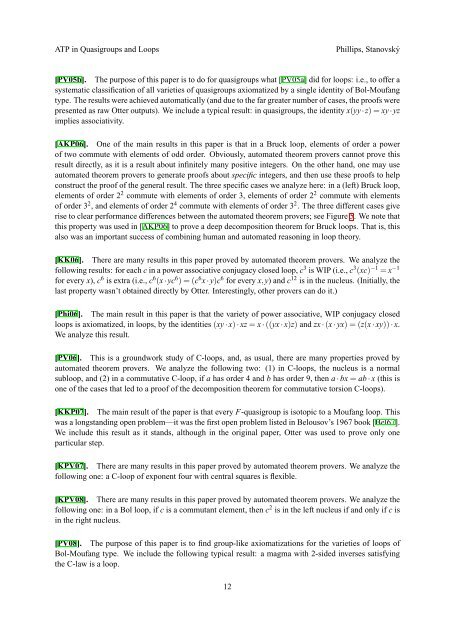Automated Theorem Proving in Quasigroup and Loop Theory
Automated Theorem Proving in Quasigroup and Loop Theory
Automated Theorem Proving in Quasigroup and Loop Theory
You also want an ePaper? Increase the reach of your titles
YUMPU automatically turns print PDFs into web optimized ePapers that Google loves.
ATP <strong>in</strong> <strong>Quasigroup</strong>s <strong>and</strong> <strong>Loop</strong>s<br />
Phillips, Stanovský<br />
[PV05b]. The purpose of this paper is to do for quasigroups what [PV05a] did for loops: i.e., to offer a<br />
systematic classification of all varieties of quasigroups axiomatized by a s<strong>in</strong>gle identity of Bol-Moufang<br />
type. The results were achieved automatically (<strong>and</strong> due to the far greater number of cases, the proofs were<br />
presented as raw Otter outputs). We <strong>in</strong>clude a typical result: <strong>in</strong> quasigroups, the identity x(yy·z) = xy·yz<br />
implies associativity.<br />
[AKP06]. One of the ma<strong>in</strong> results <strong>in</strong> this paper is that <strong>in</strong> a Bruck loop, elements of order a power<br />
of two commute with elements of odd order. Obviously, automated theorem provers cannot prove this<br />
result directly, as it is a result about <strong>in</strong>f<strong>in</strong>itely many positive <strong>in</strong>tegers. On the other h<strong>and</strong>, one may use<br />
automated theorem provers to generate proofs about specific <strong>in</strong>tegers, <strong>and</strong> then use these proofs to help<br />
construct the proof of the general result. The three specific cases we analyze here: <strong>in</strong> a (left) Bruck loop,<br />
elements of order 2 2 commute with elements of order 3, elements of order 2 2 commute with elements<br />
of order 3 2 , <strong>and</strong> elements of order 2 4 commute with elements of order 3 2 . The three different cases give<br />
rise to clear performance differences between the automated theorem provers; see Figure 5. We note that<br />
this property was used <strong>in</strong> [AKP06] to prove a deep decomposition theorem for Bruck loops. That is, this<br />
also was an important success of comb<strong>in</strong><strong>in</strong>g human <strong>and</strong> automated reason<strong>in</strong>g <strong>in</strong> loop theory.<br />
[KK06]. There are many results <strong>in</strong> this paper proved by automated theorem provers. We analyze the<br />
follow<strong>in</strong>g results: for each c <strong>in</strong> a power associative conjugacy closed loop, c 3 is WIP (i.e., c 3 (xc) −1 = x −1<br />
for every x), c 6 is extra (i.e., c 6 (x · yc 6 ) = (c 6 x · y)c 6 for every x,y) <strong>and</strong> c 12 is <strong>in</strong> the nucleus. (Initially, the<br />
last property wasn’t obta<strong>in</strong>ed directly by Otter. Interest<strong>in</strong>gly, other provers can do it.)<br />
[Phi06]. The ma<strong>in</strong> result <strong>in</strong> this paper is that the variety of power associative, WIP conjugacy closed<br />
loops is axiomatized, <strong>in</strong> loops, by the identities (xy · x) · xz = x · ((yx · x)z) <strong>and</strong> zx · (x · yx) = (z(x · xy)) · x.<br />
We analyze this result.<br />
[PV06]. This is a groundwork study of C-loops, <strong>and</strong>, as usual, there are many properties proved by<br />
automated theorem provers. We analyze the follow<strong>in</strong>g two: (1) <strong>in</strong> C-loops, the nucleus is a normal<br />
subloop, <strong>and</strong> (2) <strong>in</strong> a commutative C-loop, if a has order 4 <strong>and</strong> b has order 9, then a · bx = ab · x (this is<br />
one of the cases that led to a proof of the decomposition theorem for commutative torsion C-loops).<br />
[KKP07]. The ma<strong>in</strong> result of the paper is that every F-quasigroup is isotopic to a Moufang loop. This<br />
was a longst<strong>and</strong><strong>in</strong>g open problem—it was the first open problem listed <strong>in</strong> Belousov’s 1967 book [Bel67].<br />
We <strong>in</strong>clude this result as it st<strong>and</strong>s, although <strong>in</strong> the orig<strong>in</strong>al paper, Otter was used to prove only one<br />
particular step.<br />
[KPV07]. There are many results <strong>in</strong> this paper proved by automated theorem provers. We analyze the<br />
follow<strong>in</strong>g one: a C-loop of exponent four with central squares is flexible.<br />
[KPV08]. There are many results <strong>in</strong> this paper proved by automated theorem provers. We analyze the<br />
follow<strong>in</strong>g one: <strong>in</strong> a Bol loop, if c is a commutant element, then c 2 is <strong>in</strong> the left nucleus if <strong>and</strong> only if c is<br />
<strong>in</strong> the right nucleus.<br />
[PV08]. The purpose of this paper is to f<strong>in</strong>d group-like axiomatizations for the varieties of loops of<br />
Bol-Moufang type. We <strong>in</strong>clude the follow<strong>in</strong>g typical result: a magma with 2-sided <strong>in</strong>verses satisfy<strong>in</strong>g<br />
the C-law is a loop.<br />
12
















